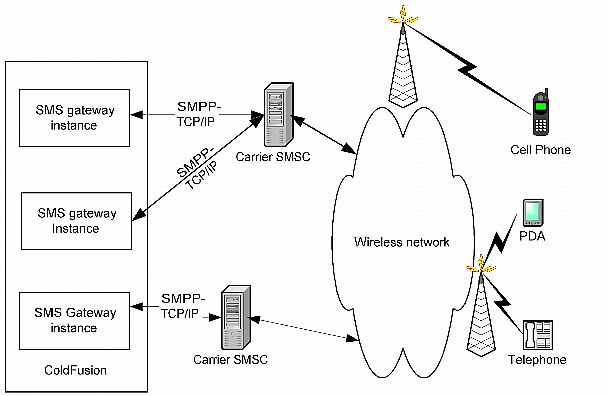
The following discussion simplifies SMS technology and describes only a typical use with a ColdFusion application. For a more complete discussion of SMS, see the publicly available literature, including the several books that discuss SMS.
In a ColdFusion SMS application, a mobile device such as a mobile phone communicates (via intermediate steps) with a message center, such as a short message service center (SMSC). For example, a mobile phone user calls a telephone number that the SMS provider has associated with your account; the SMSC gets the messages that are sent to this number. The SMSC can store and forward messages. A ColdFusion application can initiate messages to wireless devices, or it can respond to incoming messages from the devices.
The SMSC communicates with a ColdFusion SMS event gateway using short message peer-to-peer protocol (SMPP) over TCP/IP. Information is transferred by exchanging Protocol Data Units (PDUs) with structures that depend on the type of transaction, such as a normal message submission, a binary data submission, or a message intended for multiple recipients.
Because the SMSC is a store-and-forward server, it can hold messages that cannot be immediately delivered and try to deliver them when the receiving device is available. The time that a message is held on the server for delivery is configured by the SMSC provider. For example, AT&T Wireless saves messages for 72 hours; after that time, any undelivered messages are deleted. Your messages can request a different timeout (by specifying a ValidityPeriod field). The message can also use a registeredDelivery field to tell the SMSC to inform the you about whether and when the message is delivered.
SMS communication can be secure. Voice and data communications, including SMS message traffic between the SMSC and the mobile device is encrypted as part of the GSM standard. The mobile user's identity is also authenticated by the SMSC before the encrypted communication session begins. You must secure the communications between ColdFusion and the SMSC. Typically, you do this by using a secure hardware or software VPN connection around the SMPP connection.
The following figure shows the SMS path between mobile devices and ColdFusion gateways:

Using the SMS event gateway, ColdFusion establishes a two-way (transceiver) connection to the SMSC of the telecommunications carrier or other SMPP account provider. The SMPP provider assigns an address for your account, and you associate an event gateway instance with the address. Addresses are normally telephone numbers, but carriers often support "short code" addresses that do not require a full 10-digit number. You also configure the gateway instance to communicate with the provider's specified TCP/IP address using a system ID and a password.
Note: The ColdFusion MX SMS event gateway conforms to the SMPP 3.4 specification, which you can download from the SMS Forum at www.smsforum.net/.
A ColdFusion application can initiate and send messages to SMS-enabled devices by specifying the destination mobile device telephone number, or mobile devices can send messages to a ColdFusion listener CFC by using the gateway instance's telephone number. Incoming messages include the sender's number, so listener CFCs can respond to messages sent by mobile devices.